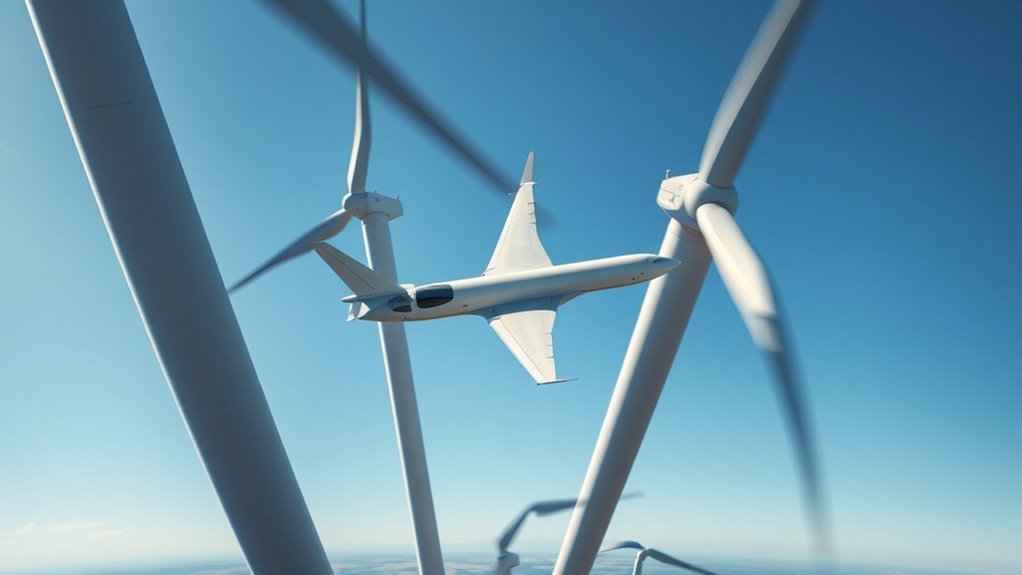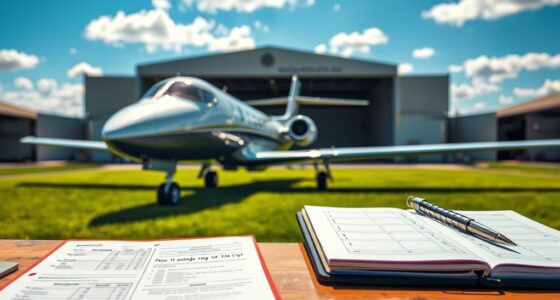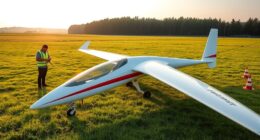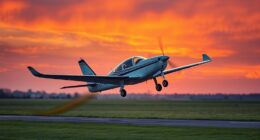Flying close to wind turbines exposes you to hazards like wake turbulence, which can destabilize your aircraft or drone. The complex airflow caused by spinning blades and multiple turbines makes control difficult and increases collision risks. Unpredictable gusts and turbulent air can lead to sudden altitude changes and loss of situational awareness. Keeping a safe distance helps prevent these dangers and ensures safe navigation—continue exploring to understand how to protect yourself and your equipment better.
Key Takeaways
- Wind turbines generate wake turbulence that can destabilize aircraft and drones flying nearby.
- Turbulent airflow from turbines extends into surrounding airspace, creating unpredictable conditions.
- Wake turbulence trails can cause sudden altitude changes and loss of control.
- Complex airflow patterns hinder navigation and increase collision risks near wind farms.
- Maintaining safe distances from turbines reduces hazards from wake turbulence and airflow interference.
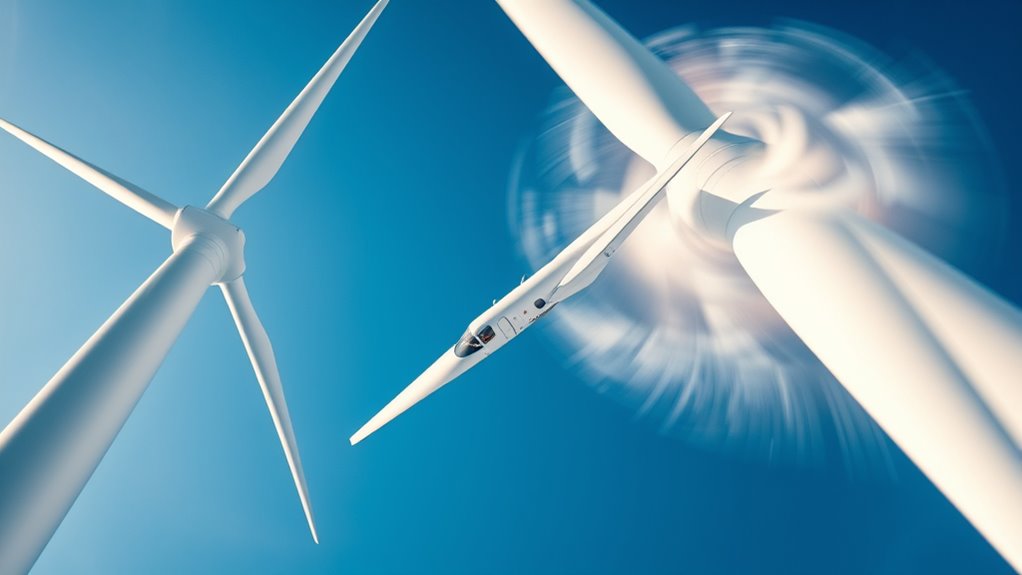
Flying near wind turbines can pose significant hazards that often go unnoticed. As a pilot or drone operator, you might not realize how the presence of wind turbines impacts your flight safety, especially concerning turbine blade safety and wind farm interference. These structures are designed to harness wind energy efficiently, but they also create complex airflow patterns that can unexpectedly disrupt your flight path. Understanding these hazards is vital to avoid accidents and guarantee safe navigation through wind farm areas.
One of the primary concerns is turbine blade safety. While wind turbines are built with safety margins, their spinning blades generate intense vortices and turbulent air currents. When you fly close to or through these areas, you risk encountering unpredictable wind gusts that can destabilize your aircraft or drone. The blades themselves can cause wake turbulence, which trails behind the turbine and can extend for considerable distances. This turbulence can cause sudden altitude changes or unpredictable movements, especially if you’re operating at lower altitudes near the turbines. It’s important to maintain a safe distance to avoid these hazardous wake effects, as the turbulent air can catch you off guard, even if you’re experienced.
Wind farm interference is another significant challenge. The presence of multiple turbines creates a complex maze of airflow patterns. These interfere with your flight by producing fluctuating wind speeds and directions, which can compromise control and stability. When flying near a wind farm, you might notice that your aircraft or drone reacts differently to wind gusts than it normally would. These interference patterns can also cause consistent shifts in wind direction, making navigation more difficult. If you’re not vigilant, you might inadvertently drift closer to turbines or into areas with higher turbulence, increasing the risk of collision or loss of control.
Furthermore, the risk isn’t limited to just physical collision with blades; the turbulence and wind farm interference can also impact your visibility and situational awareness. You may find it harder to judge distances or maintain a steady course when gusts are unpredictable. This is especially dangerous during takeoff, landing, or low-altitude maneuvers near turbines, where even minor disturbances can have serious consequences. Additionally, understanding the color accuracy of your aircraft’s sensors and instruments can help better interpret changing airflow conditions, enhancing safety.
To guarantee safety, always adhere to recommended distances from wind turbines, be aware of airflow patterns within wind farms, and stay updated on regulations governing flight near these structures. Recognizing the hazards related to turbine blade safety and wind farm interference helps you make smarter decisions, reducing the risk of accidents. Ultimately, respecting these dangers allows you to fly safely and responsibly around wind turbines, protecting both your equipment and yourself.
Frequently Asked Questions
How Do Wind Turbine Blade Rotations Affect Nearby Aircraft?
When you fly near wind turbines, the rotor vortex and blade wash can impact your aircraft. The rotating blades create turbulent airflow, which can cause sudden shifts in lift and stability. These disturbances, caused by rotor vortex and blade wash, may lead to unexpected maneuvers or loss of control if you’re too close. Always maintain a safe distance to avoid these aerodynamic effects and guarantee a safe flight.
Are There Specific Regulations for Flying Close to Wind Farms?
Yes, there are specific regulations for flying close to wind farms. You should follow safety guidelines and be aware that regulation enforcement differs by region. Pilots are typically advised to maintain a safe distance from wind turbines and avoid flying directly over them, especially at lower altitudes. Always check local airspace rules and notices to guarantee you’re compliant, minimizing risks associated with wake turbulence and other hazards.
Can Wind Turbines Cause GPS Navigation Issues for Aircraft?
You might find that wind turbines can cause GPS interference, leading to minor navigational disruptions. While modern aircraft systems are designed to handle such challenges, it’s wise to stay vigilant near large wind farms. These structures can occasionally impact signal accuracy, but pilots and air traffic controllers work together to ensure safe navigation. So, enjoy your flight, knowing that safety measures are in place to address potential GPS issues around wind turbines.
What Are the Best Practices for Pilots Near Wind Turbines?
When flying near wind turbines, you should maintain a safe distance to avoid turbine noise interference and bird collisions. Use visual cues to spot turbines early, and stay alert for wake turbulence. Keep your altitude and speed appropriate, and communicate with air traffic control if you notice potential hazards. Avoid flying directly downwind of turbines, as wake turbulence can affect aircraft stability. Always prioritize safety and stay vigilant in these areas.
How Does Turbine Maintenance Impact Airspace Safety?
Turbine maintenance directly impacts airspace safety because it can create temporary hazards like equipment parts or support vehicles in the vicinity. When maintenance occurs, you need to stay alert, follow updated notices, and avoid restricted zones. Proper communication and coordination ensure you’re aware of maintenance schedules, reducing risks. By staying vigilant and respecting maintenance zones, you help uphold safe airspace conditions around wind farms.
Conclusion
Controlling near wind turbines is like dancing with invisible giants; their wake turbulence can toss your plane off course, turning smooth skies into a turbulent sea. Stay alert and keep your eyes on the horizon, because these towering sentinels hide hazards that can catch you unaware. Remember, respecting their power keeps your flight smooth and safe—don’t let wind energy’s gentle giants become the storm that disrupts your journey through the skies.
With a heart that soars as high as the skies, Aria, affectionately known as “Skylark,” is the driving force behind Soaring Skyways. Her journey into the gliding world began as a young dreamer gazing up at the soaring birds, yearning to experience the weightlessness and freedom they embodied. With years of experience both in the cockpit and behind the scenes, Aria’s commitment to the gliding community is unwavering.
